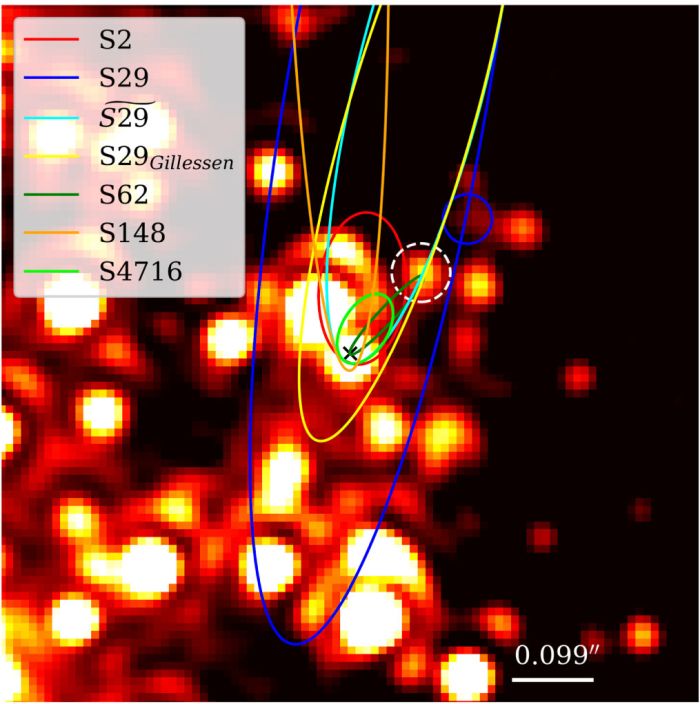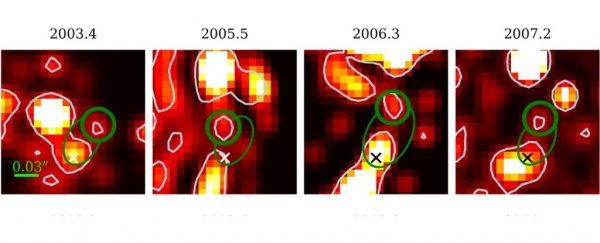A newly discovered star is so close to our galaxy's central supermassive black hole that it completes an orbit in just four years.
That's the shortest orbit yet for one of the stars looping around the Sagittarius A*. It's an oval-shaped journey around the black hole that brings the star to orbital velocities over 2.5 percent of the speed of light.
The discovery adds fascinating new information about the strange dynamics of the center of the Milky Way.
Although our galactic center is pretty quiet compared to other galaxies, the environment around Sgr A* is an extreme sort of place. The black hole is a monster, clocking in at around 4 million times the mass of the Sun. Before astronomers confirmed its existence with a direct image, scientists inferred its presence and calculated its mass based on a star locked in orbit around Sgr A*.
That star, called S2, is just one of a group of stars known as S-stars, which follow long, sharply elliptical orbits around Sgr A*, with the black hole at one end of the ellipse. That end, at which the star is closest to the black hole, is periapse, and the way stars change their velocities as they move into and out of periapse is one of the tools that helped 'weigh' the black hole.
But S2 is far from the only star at the party.
A team of astrophysicists led by Florian Peissker at the University of Cologne in Germany has been looking to see what else they might turn up in this weird, high-speed treasure trove.
"S2 behaves like a large person sitting in front of you in a movie theater: It blocks your view of what's important," Peissker explained. "The view into the center of our galaxy is therefore often obscured by S2. However, in brief moments we can observe the surroundings of the central black hole."
 The orbits of several S stars in the galactic center. (Peissker et al., ApJ, 2022)
The orbits of several S stars in the galactic center. (Peissker et al., ApJ, 2022)
Researchers discovered this star, named S4716, thanks to the evolution of observation and analysis techniques. It was clearly seen in data from five different instruments on its breakneck orbit around Sgr A*.
The team calculated that its periapse was about 15 billion kilometers (9.3 billion miles) from the supermassive black hole, about 100 times the distance between Earth and the Sun. As it approaches and enters periapse, the star reaches a velocity of about 8,000 kilometers (4,970 miles) per second.
That's not the closest, nor the fastest, S star in the galactic center. That honor belongs to a star named S4714, also discovered by Peissker and his colleagues, which comes as close to Sgr A* as 1.9 billion kilometers, reaching velocities up to 24,000 kilometers per second.
However, S4714 has an orbital period of 12 years. S4716, with its four-year orbit, has the shortest mean distance to the black hole throughout its entire orbit of any of the S stars discovered to date.
"For a star to be in a stable orbit so close and fast in the vicinity of a supermassive black hole was completely unexpected and marks the limit that can be observed with traditional telescopes," Peissker said.
The discovery tidies up several oddities in previous observations attributed to other S stars. However, S4716 presents something of a new mystery: It's not entirely clear how it got there. This, the researchers said, may take some more work to solve.
"The short-period, compact orbit of S4716 is quite puzzling," said astrophysicist Michael Zajaček of Masaryk University in Czechia.
"Stars cannot form so easily near the black hole. S4716 had to move inwards, for example by approaching other stars and objects in the S cluster, which caused its orbit to shrink significantly."
The research has been published in The Astrophysical Journal.
